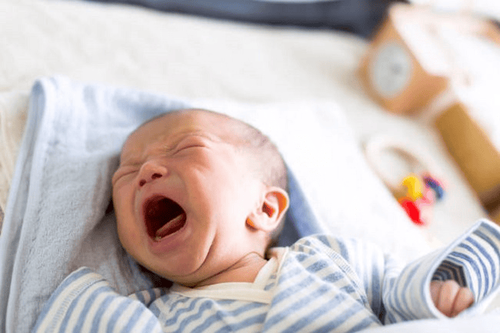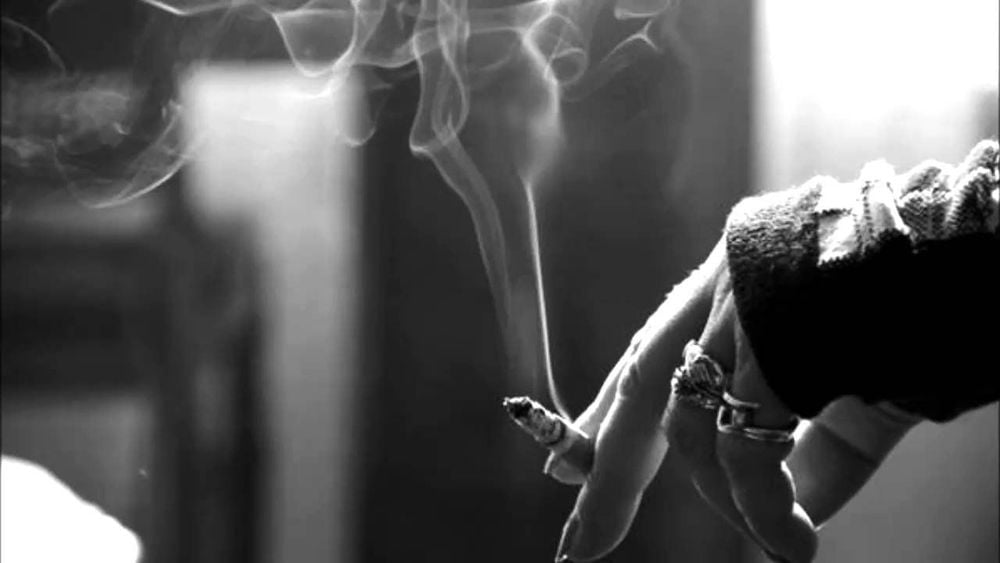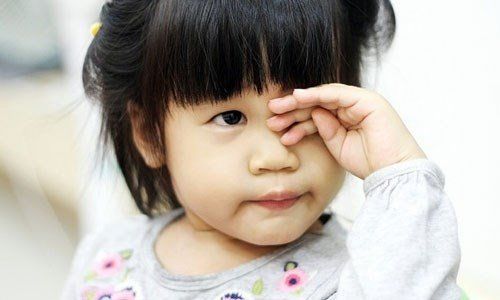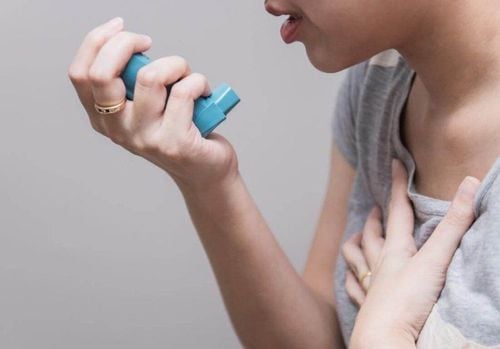This is an automatically translated article.
The article was professionally consulted by resident Doctor Duong Van Sy - Department of Pediatrics - Neonatology - Vinmec Hai Phong International General Hospital. Doctor has 09 years of experience in the field of Pediatrics.Some children with asthma only have wheezing when they have a cold or an upper respiratory infection. This is thought to be a lifelong condition, but the frequency and severity of symptoms may change as your child gets older.
1. Asthma in infants and children
Asthma is an inflammation of the lungs and airways, which transport air in and out of the lungs. If a child has asthma, the airways become irritated and swollen, which can affect the ability to breathe.Asthma is the most common serious chronic illness in children and the third leading cause of hospitalization in children under 15 years of age. Currently, the disease affects about 1 in 12 children in the United States. At least half of children with asthma develop symptoms before the age of 5.
It is important for parents to work with their doctor to prevent and treat asthma attacks. With the right medications, instruction in asthma management and control, and regular medical monitoring, most children with asthma can grow up to be fairly healthy.
2. Asthma symptoms in infants and children
Signs of asthma in children may include:Rapid or difficult breathing (which may manifest as a tight or tight chest or a puffy nose) Frequent, long exhalation (especially when playing) Chest tightness (young children may just say chest pain or feel chest discomfort) Wheezing or a hissing sound when exhaling Cough (especially at night) Pale face, lips or fingernails pale, bluish during asthma attacks Difficulty eating Frequent colds Fatigue (which prevents your baby from playing or participating in sports). Breathing problems can also affect a child's sleep. Infants with asthma may also show the following signs:
Difficulty suckling or grimacing when fed Wheezing Or fussy. Accordingly, it should be noted that many other diseases such as croup, respiratory syncytial virus - RSV, acid reflux, pneumonia, colds and cystic fibrosis can also cause similar symptoms. In fact, most children's wheezing is a sign of bronchiolitis - which occurs when the virus enters the lungs in children under 2 years of age, which clears up within 1-2 weeks. Certain other viral infections can also increase a child's risk of developing asthma later in life.

3. Symptoms of an asthma attack and how to manage it
Signs that a child is having an acute asthma attack include:Panting Breathing so hard that the abdomen pulls in under the ribs (contraction) The baby raises its head or opens its nostrils wide to breathe. The skin turns pale. or pale Unable to talk because of difficulty breathing. Without treatment or delayed medical care, an asthma attack can be life-threatening. So, as soon as you notice any symptoms of an asthma attack, do:
Promptly give your child a “quick reliever” medicine as prescribed by the doctor. If any emergency medicine is not available, call 911 or take the child to the nearest emergency room. As the medication works to open up the airways, symptoms should subside. Patients may have to take repeated doses of emergency medicine to prevent recurrence of symptoms. If symptoms persist or get worse, call 911 or take the child to the emergency room right away.
4. Diagnosing a child with asthma
The doctor can help determine if your child's symptoms are caused by asthma. Often, asthma in infants younger than 2 years of age can be difficult to diagnose, as other conditions cause similar wheezing sounds. As mentioned, viral respiratory infections are the most common cause of wheezing in infants and young children, which is why many doctors do not definitively diagnose infants with asthma. until the child is 2 years old.However, if your child coughs frequently and has allergies or eczema, and your family has a history of asthma and allergies or eczema (especially if you and your wife both have them), then it's more likely. Your baby will continue to have asthma.
To find out if your child has asthma, the doctor will:
Take a careful medical and family history, ask about your child's symptoms and when they occurred. Physical examination. Order pulmonary function tests (inhaling a device that measures the flow of air in and out of the lungs), blood tests, allergy tests, and X-rays. Sometimes the doctor will also prescribe medication to see if that helps the child to improve breathing.

5. Prevention of Asthma in Infants and Children
You can't completely prevent asthma if your child already carries this gene. You also won't know if your child has asthma until you see persistent symptoms, such as wheezing and persistent coughing.Parents can only reduce the severity of symptoms or delay an asthma attack as the child gets older (the child's lungs get bigger and stronger) by:
Identifying and minimizing the triggers If If your child has asthma, find out what causes symptoms and asthma flare-ups. Some children only show symptoms when they have a cold, while others need to avoid contact with cat hair or cigarette smoke.
Limit exposure to dust mites Cover your child's mattress with a waterproof sheet, avoid carpets and stuffed toys, use drapes instead of heavy drapes, and wash your child's bed sheets once a week with water hot.
Stay away from secondhand smoke Although secondhand smoke is not an allergen, it can irritate the lungs. Therefore, it is necessary for children to stay away from secondhand smoke.
Limit children's exposure to polluted air Air pollution can cause lung irritation and breathing problems in sensitive individuals. Check the Air Quality Index news or app and consider keeping kids indoors on poor air quality days.
Avoid using fireplaces or wood stoves Although providing warmth on winter days, smoke can irritate a child's respiratory system.
Limit contact with pet hair If children have allergies, parents should keep pets outside. However, this choice depends on the personality of the pet and your family's living situation.
Reduce indoor mold Install exhaust fans or open windows when cooking and taking hot showers. Using an air conditioner or dehumidifier (if needed), keep the humidity between 35 - 50%. Repair leaks, which can cause mold behind walls and under floors, and clean moldy surfaces with soap and water. Make sure wet clothing or surfaces are dried as soon as possible to prevent mold growth.
There is no cure for asthma. However, close medical monitoring and proper treatment will help your child control the disease as he gets older so he can run, swim, and play like other children. Asthma in babies can be scary for your family, but the reality is that many children are still facing this disease. Most babies with asthma grow up to have a better chance of becoming healthy adults.
When children have signs of asthma, parents should quickly take their children to medical facilities for timely diagnosis and treatment. Depending on the condition of the child, the doctor will have an appropriate treatment method. Parents' compliance with the doctor's instructions and the correct use of prescribed medicines to relieve or prevent asthma have great implications for the health and quality of life of their children.

Screening for early detection to promptly control and treat the disease. Performing clinical examination, taking medical history, measuring respiratory function, otolaryngology examination and screening for bronchial asthma. The entire process of examination and screening for asthma at Vinmec is carried out methodically and in accordance with the correct procedure, providing accurate results, quick recovery time, and limiting dangerous complications for children.
In addition, to avoid asthma in children, parents should also add some supportive foods containing lysine, essential micro-minerals and vitamins such as zinc, chromium, selenium, and B vitamins. , ... helps to fully meet the nutritional needs. At the same time, supporting the immune system, enhancing resistance, reducing the risk of upper respiratory tract infections, pneumonia, bronchitis, flu,...
Please dial HOTLINE for more information or register for an appointment HERE. Download MyVinmec app to make appointments faster and to manage your bookings easily.
Reference source: .babycenter.com





![[Vinmec - Q&A with experts] Number 02: Children's health in hot season (Part 2)](/static/uploads/20190724_082648_029405_tre_em_max_1800x1800_jpg_6420fc1d62.jpg)







